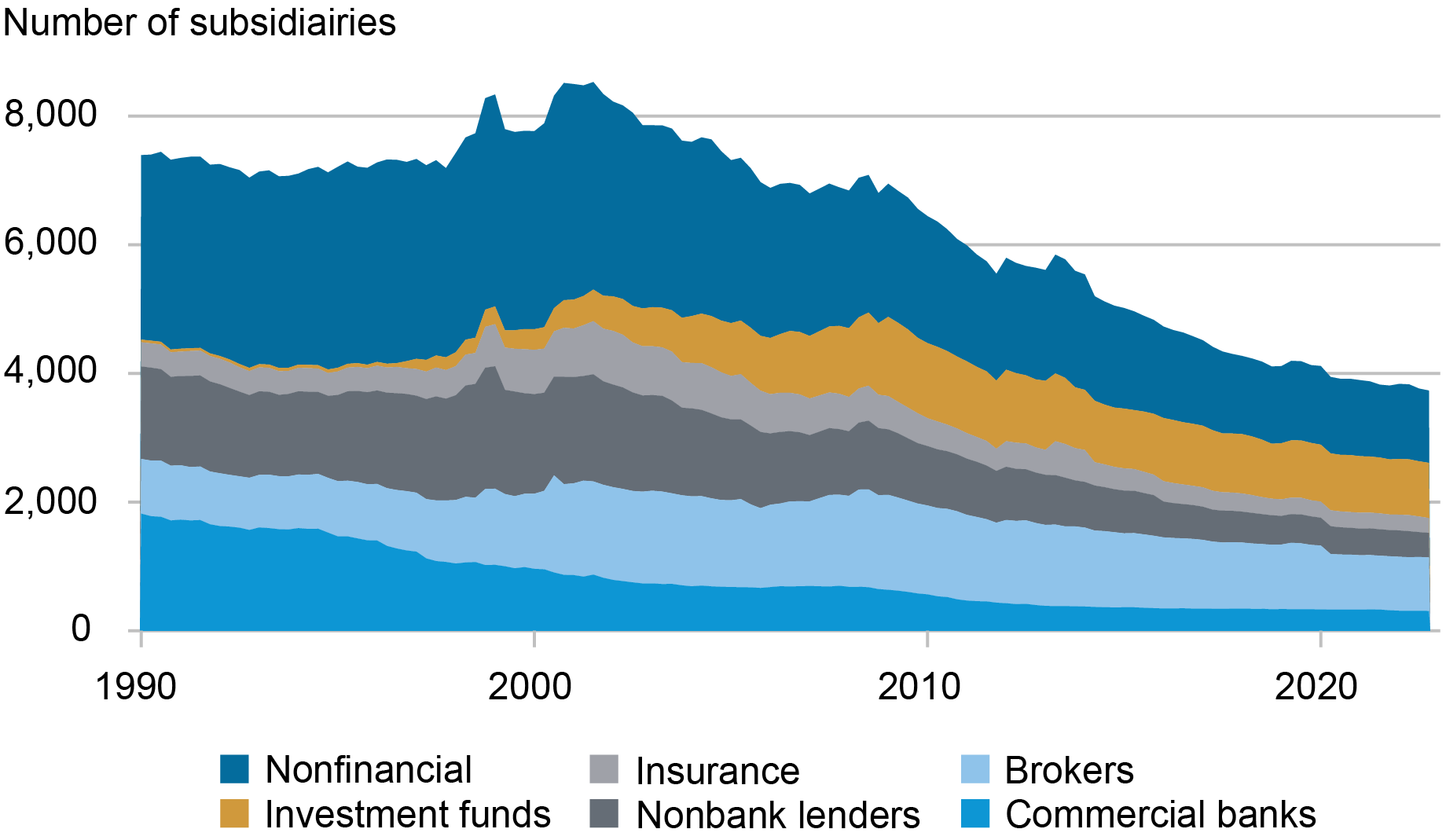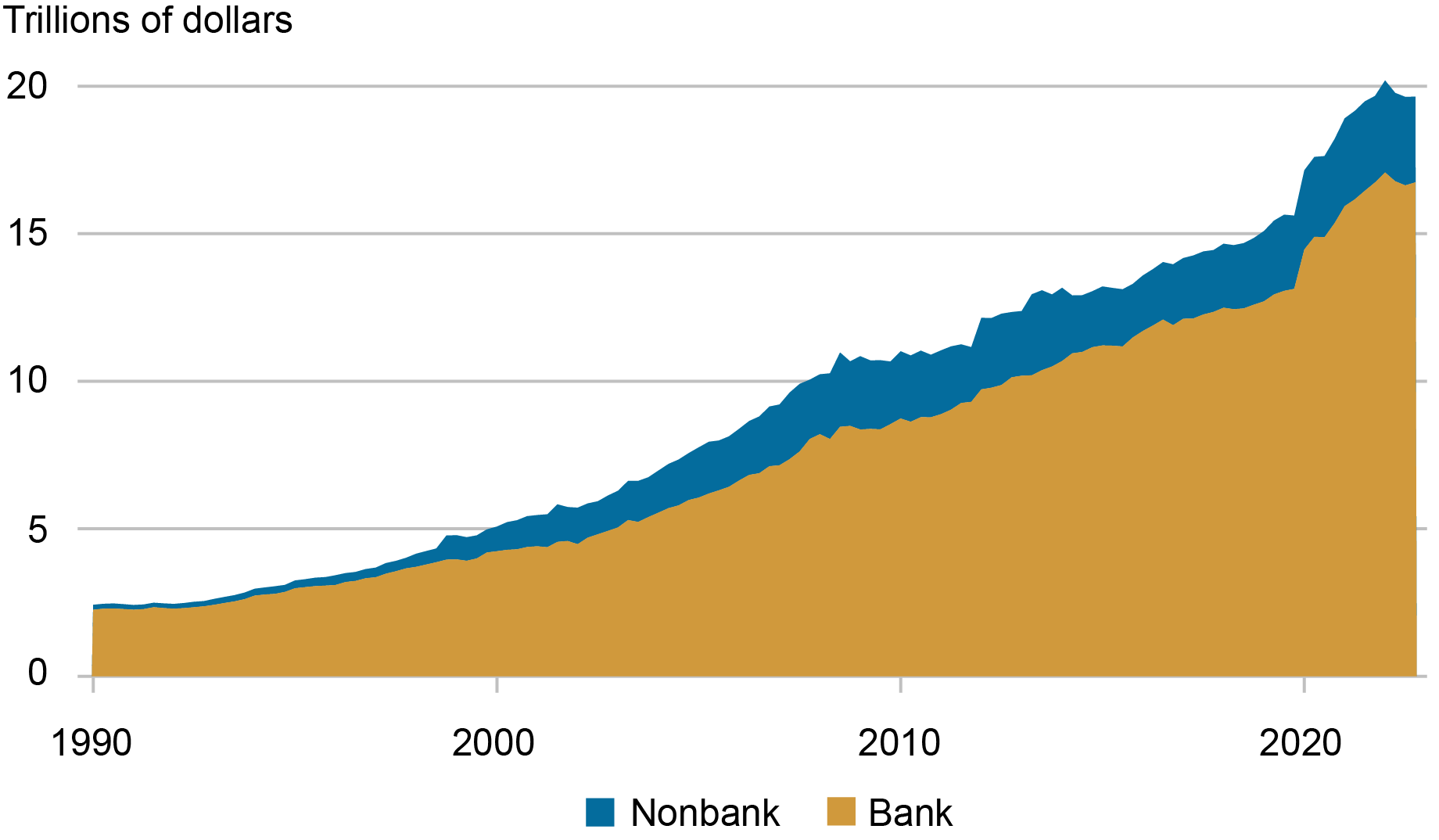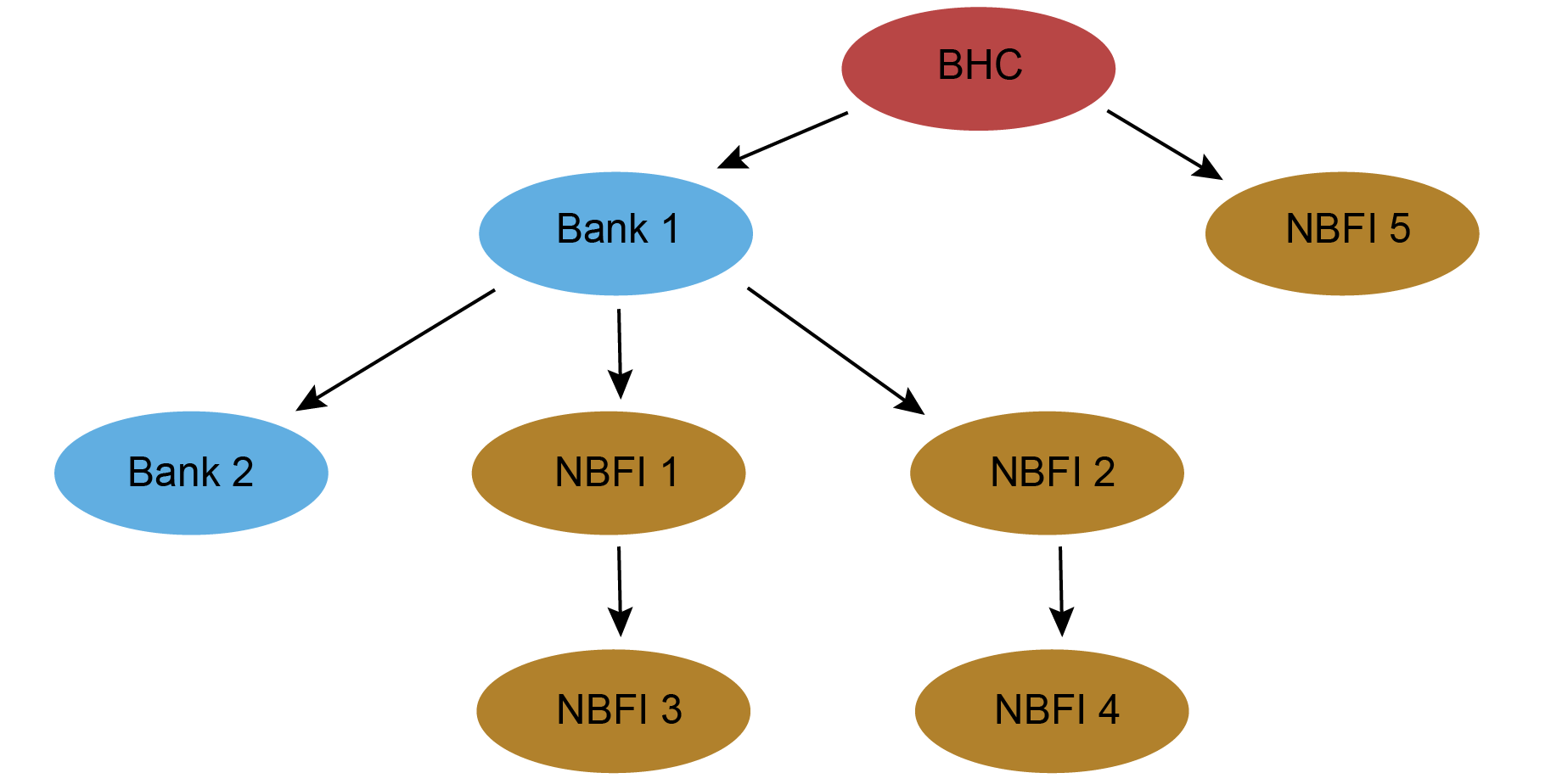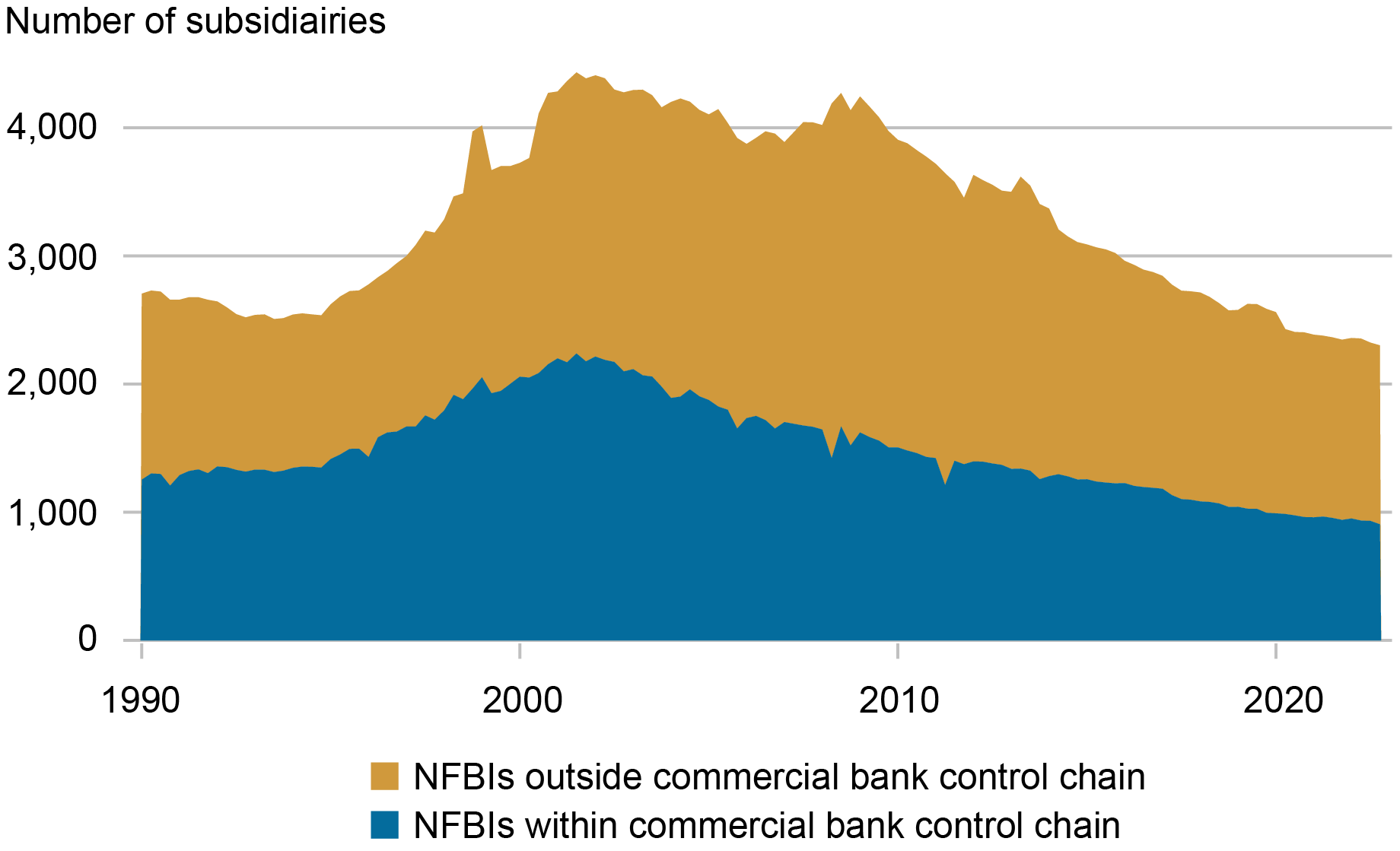
[ad_1]

Monetary and technological innovation and adjustments within the macroeconomic setting have led to the expansion of nonbank monetary establishments (NBFIs), and to the attainable displacement of banks within the provision of conventional monetary intermediation companies (deposit taking, mortgage making, and facilitation of funds). On this publish, we take a look at the joint evolution of banks—known as depository establishments from right here on—and nonbanks contained in the organizational construction of financial institution holding corporations (BHCs). Utilizing a distinctive database of the organizational construction of all BHCs ever in existence because the Seventies, we doc the evolution of NBFI actions inside BHCs. Our proof means that there exist vital conglomeration synergies to having each banks and NBFIs beneath the identical organizational umbrella.
The Evolution of Banks and Nonbanks: Different Views
The standard view of monetary intermediation is that banks and nonbanks evolve independently. Banks are basically depository establishment that make loans and facilitate funds, and their evolution stays anchored on these “core” actions. NBFIs, however, are seen as a heterogenous bunch—insurers, specialty lenders, funding funds, et cetera, with every phase working beneath distinct enterprise fashions, governing constructions, and even laws. One commonality of NBFIs, nonetheless, is that they will substitute for banks as monetary intermediaries.
Another view is that banks evolve and adapt their enterprise mannequin to the prevalent mode of monetary intermediation. Below this view, the evolution of banks and nonbanks is extremely intertwined. For instance, monetary innovation and regulatory adjustments within the Nineties enhanced asset securitization, shifting the prevalent mode of monetary intermediation from a bank-centric mannequin of taking deposits and issuing loans (and holding them to maturity) to a brand new mannequin the place loans have been packaged into securities and bought to traders. With this shift, a number of nonbank actions involving the availability of specialised companies in assist of the securitization course of (comparable to specialty lending, making markets, managing property, and insurance coverage) grew in significance. Relatively than remaining passive observers of those developments, banks tailored their enterprise fashions and more and more integrated these new actions beneath their organizational umbrellas to benefit from synergistic advantages. This various view implies that banks and NBFI actions could also be complementary to at least one one other and never substitutes.
On this publish, we offer ample assist for that various view. Our distinctive database of the organizational construction of all BHCs permits us to trace every subsidiary within the banking business during the last fifty years, map the subsidiary to its direct guardian and to its final guardian, and observe the exercise that the subsidiary is engaged in. Utilizing this knowledge, we describe the joint evolution of banks and nonbanks over the previous thirty years.
The Co-Evolution of Banks and Nonbanks
BHCs have traditionally had a considerable nonbank footprint. Within the chart beneath, we decompose the actions of BHCs’ subsidiaries. For every quarter from 1990 to 2022, we choose the highest 200 BHCs by property (collectively holding roughly 90 p.c of business property), excluding Goldman Sachs, Morgan Stanley, and different BHCs that solely entered the business later within the pattern interval. We discover that BHCs have 1000’s of subsidiaries, the overwhelming majority of that are nonbanks. Through the years, BHCs have added entities comparable to nonbank lenders, broker-dealers, asset administration establishments (funds), and insurers, amongst others. As of 2022:This fall, solely about 8 p.c of BHC subsidiaries have been categorized as business banks (depository establishments).
Composition of BHC Subsidiaries by Exercise

Sources: FR Y-10; authors’ calculations.
Word: We exclude the next BHCs: Goldman Sachs, Morgan Stanley, American Specific, CIT Group, Ally Monetary, Uncover, M&T Financial institution, MetLife.
A view of nonbank actions centered on subsidiary counts could also be deceptive as a result of these entities may simply be empty shells created for authorized causes, or they may very well be incidental to the enterprise, just like the nonfinancial subsidiaries we observe within the chart above, however not essentially reflecting actions the BHCs interact in. As a substitute, we discover that nonbank subsidiaries are significant contributors to the enterprise mannequin of BHCs, as measured by the composition of their property and revenue. Within the chart beneath, we decompose the property of the highest 200 BHCs by subsidiary kind: financial institution or nonbank. To take action, we benefit from a lesser utilized reporting kind, the FR Y-9LP, which captures the unconsolidated stability sheet of BHCs’ guardian corporations (or intermediate holding corporations). Because the chart exhibits, NBFIs account for a steadily rising share of whole BHC property—about 15 p.c, or greater than $2.9 trillion, as of 2022:This fall.
Composition of BHC Property

Sources: FR Y9-LP; FR Y9-C; FR Y-10; creator’s calculations.
Word: We exclude the next BHCs: Goldman Sachs, Morgan Stanley, American Specific, CIT Group, Ally Monetary, Uncover, M&T Financial institution, MetLife.
An identical image seems when trying on the prime 200 BHCs by working revenues, outlined as curiosity revenue plus noninterest revenue. Within the subsequent chart, we decompose BHC working revenues, utilizing nonbank working income from the FR Y-9LP and whole BHC working income from the FR Y-9C (the consolidated stability sheet of BHCs). NBFIs’ share of whole working income has additionally been rising over time, representing roughly 21 p.c of BHCs’ whole working income in 2022:This fall.
Composition of BHC Working Income

Sources: FR Y9-LP; FR Y9-C; FR Y-10; authors’ calculations.
Word: We exclude the next BHCs: Goldman Sachs, Morgan Stanley, American Specific, CIT Group, Ally Monetary, Uncover, M&T Financial institution, MetLife.
Whereas the proof exhibits that NBFIs have had a big position inside BHCs over time, what’s the relationship between NBFIs and “core” depository establishments? Did banking corporations merely pursue a technique of organizational diversification, or did they acknowledge the potential existence of conglomeration advantages between banks and NBFIs? Within the latter case, possession or controlling pursuits in each kinds of establishments could enable the exploitation of synergies, thus creating advantages for the group as an entire.
To discover this problem, we contemplate the tiering construction inside every BHC in our database, which permits us to establish each the final word guardian of a given subsidiary in addition to the intermediate entities holding the subsidiary earlier than the guardian. Within the diagram beneath, we present a stylized instance of an organizational construction. The diagram establishes that “NBFI 1” is finally a subsidiary of the guardian BHC and is instantly owned by the depository establishment “Financial institution 1,” which in flip is instantly owned by the guardian BHC.
Instance of BHC Organizational Construction

We argue that the choice to nest subsidiaries inside inner management chains could mirror the capability of these linked subsidiaries to generate conglomeration advantages. Specifically, the extent to which depository establishment subsidiaries of BHCs instantly management NBFI subsidiaries (as “Financial institution 1” controls NBFIs 1-4) captures the extent to which the “core” parts of a banking agency—the depository establishments—are carefully linked to the nonbank aspect.
Within the chart beneath, we present how the variety of NBFI subsidiaries throughout the prime 200 BHCs which might be managed by depository establishments, by each direct and oblique possession, has developed relative to the overall variety of NBFI subsidiaries beneath a BHC umbrella. We discover that the variety of nonbank subsidiaries nested beneath a depository establishment, and thus a part of a depository establishment’s direct management chain inside a BHC, has been fairly substantial over time. Nonbanks have solid an extended shadow over core banking actions for a very long time.
Composition of BHC Nonbank Subsidiaries by Management Chain

Sources: FR Y-10; authors’ calculations.
Word: We exclude the next BHCs: Goldman Sachs, Morgan Stanley, American Specific, CIT Group, Ally Monetary, Uncover, M&T Financial institution, MetLife.
Nonbank Evolution and Dwelling Wills
The identical chart exhibits that, after the GFC, the depend of NBFI subsidiaries decreases fairly considerably. Apparently, this development reversal coincides with the biggest BHCs changing into topic to decision plans, or “residing wills,” beneath the Dodd-Frank Act. Dwelling wills pressured banks to create a blueprint for a way they may very well be resolved in chapter with out undue spillovers to the remainder of the system. Specifically, residing wills are thought to have pressured banks to create extra organizational separation between depository establishments and nonbank actions. For instance, Goldman Sachs in its 2015 residing will submission writes: “We have now established a lot of standards for a much less complicated and extra rational authorized entity construction with the aim of… defending our insured depository establishment from losses incurred by non-bank associates” (see web page 15). Nevertheless, given the historical past of banking corporations adapting and evolving round regulatory boundaries, there’s a likelihood that the bank-NBFI nexus we’ve recognized could not have disappeared, however merely shifted to a distinct kind. In a forthcoming paper, we examine these questions at larger size, and we’ll report on our findings in subsequent posts.

Nicola Cetorelli is the pinnacle of Non-Financial institution Monetary Establishment Research within the Federal Reserve Financial institution of New York’s Analysis and Statistics Group.

Saketh Prazad is a analysis analyst within the Federal Reserve Financial institution of New York’s Analysis and Statistics Group.
cite this publish:
Nicola Cetorelli and Saketh Prazad, “The Nonbank Shadow of Banks,” Federal Reserve Financial institution of New York Liberty Avenue Economics, November 27, 2023, https://libertystreeteconomics.newyorkfed.org/2023/11/the-nonbank-shadow-of-banks/.
Disclaimer
The views expressed on this publish are these of the creator(s) and don’t essentially mirror the place of the Federal Reserve Financial institution of New York or the Federal Reserve System. Any errors or omissions are the duty of the creator(s).
[ad_2]